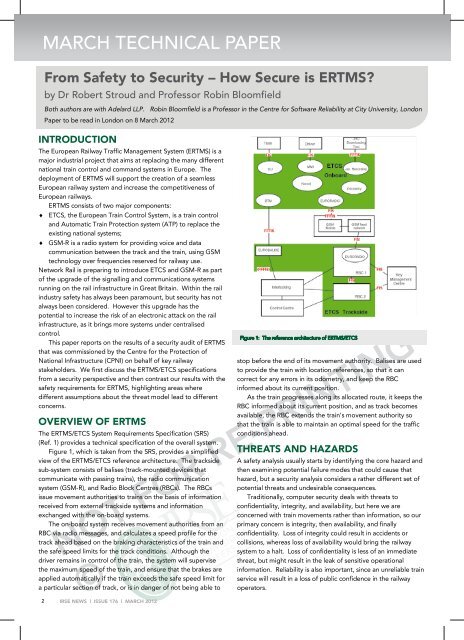IRSE News 176 Mar 12 with Watermark.pdf
IRSE News 176 Mar 12 with Watermark.pdf
IRSE News 176 Mar 12 with Watermark.pdf
You also want an ePaper? Increase the reach of your titles
YUMPU automatically turns print PDFs into web optimized ePapers that Google loves.
MARCH TECHNICAL PAPER<br />
From Safety to Security – How Secure is ERTMS?<br />
by Dr Robert Stroud and Professor Robin Bloomfield<br />
Both authors are <strong>with</strong> Adelard LLP. Robin Bloomfield is a Professor in the Centre for Software Reliability at City University, London<br />
Paper to be read in London on 8 <strong>Mar</strong>ch 20<strong>12</strong><br />
INTRODUCTION<br />
The European Railway Traffic Management System (ERTMS) is a<br />
major industrial project that aims at replacing the many different<br />
national train control and command systems in Europe. The<br />
deployment of ERTMS will support the creation of a seamless<br />
European railway system and increase the competitiveness of<br />
European railways.<br />
ERTMS consists of two major components:<br />
ETCS, the European Train Control System, is a train control<br />
and Automatic Train Protection system (ATP) to replace the<br />
existing national systems;<br />
GSM-R is a radio system for providing voice and data<br />
communication between the track and the train, using GSM<br />
technology over frequencies reserved for railway use.<br />
Network Rail is preparing to introduce ETCS and GSM-R as part<br />
of the upgrade of the signalling and communications systems<br />
running on the rail infrastructure in Great Britain. Within the rail<br />
industry safety has always been paramount, but security has not<br />
always been considered. However this upgrade has the<br />
potential to increase the risk of an electronic attack on the rail<br />
infrastructure, as it brings more systems under centralised<br />
control.<br />
This paper reports on the results of a security audit of ERTMS<br />
that was commissioned by the Centre for the Protection of<br />
National Infrastructure (CPNI) on behalf of key railway<br />
stakeholders. We first discuss the ERTMS/ETCS specifications<br />
from a security perspective and then contrast our results <strong>with</strong> the<br />
safety requirements for ERTMS, highlighting areas where<br />
different assumptions about the threat model lead to different<br />
concerns.<br />
OVERVIEW OF ERTMS<br />
The ERTMS/ETCS System Requirements Specification (SRS)<br />
(Ref. 1) provides a technical specification of the overall system.<br />
Figure 1, which is taken from the SRS, provides a simplified<br />
view of the ERTMS/ETCS reference architecture. The trackside<br />
sub-system consists of balises (track-mounted devices that<br />
communicate <strong>with</strong> passing trains), the radio communication<br />
system (GSM-R), and Radio Block Centres (RBCs). The RBCs<br />
issue movement authorities to trains on the basis of information<br />
received from external trackside systems and information<br />
exchanged <strong>with</strong> the on-board systems.<br />
The on-board system receives movement authorities from an<br />
RBC via radio messages, and calculates a speed profile for the<br />
track ahead based on the braking characteristics of the train and<br />
the safe speed limits for the track conditions. Although the<br />
driver remains in control of the train, the system will supervise<br />
the maximum speed of the train, and ensure that the brakes are<br />
applied automatically if the train exceeds the safe speed limit for<br />
a particular section of track, or is in danger of not being able to<br />
2<br />
NOT FOR RE-PRINTING<br />
©<br />
<strong>IRSE</strong> NEWS | ISSUE <strong>176</strong> | MARCH 20<strong>12</strong><br />
Figure 1: The reference architecture of ERTMS/ETCS<br />
stop before the end of its movement authority. Balises are used<br />
to provide the train <strong>with</strong> location references, so that it can<br />
correct for any errors in its odometry, and keep the RBC<br />
informed about its current position.<br />
As the train progresses along its allocated route, it keeps the<br />
RBC informed about its current position, and as track becomes<br />
available, the RBC extends the train’s movement authority so<br />
that the train is able to maintain an optimal speed for the traffic<br />
conditions ahead.<br />
THREATS AND HAZARDS<br />
A safety analysis usually starts by identifying the core hazard and<br />
then examining potential failure modes that could cause that<br />
hazard, but a security analysis considers a rather different set of<br />
potential threats and undesirable consequences.<br />
Traditionally, computer security deals <strong>with</strong> threats to<br />
confidentiality, integrity, and availability, but here we are<br />
concerned <strong>with</strong> train movements rather than information, so our<br />
primary concern is integrity, then availability, and finally<br />
confidentiality. Loss of integrity could result in accidents or<br />
collisions, whereas loss of availability would bring the railway<br />
system to a halt. Loss of confidentiality is less of an immediate<br />
threat, but might result in the leak of sensitive operational<br />
information. Reliability is also important, since an unreliable train<br />
service will result in a loss of public confidence in the railway<br />
operators.
















